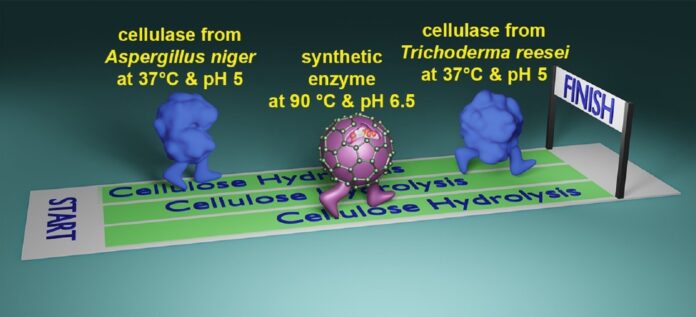Enzymes are naturally occurring proteins that operate as catalysts, controlling the chemical reactions that keep biological processes running and living things alive. They accelerate cell metabolism, including breaking down food for digestion. Three enzymes, endocellulase, exocellulase, and beta-glucosidase, can break down and digest plant fiber, Cellulose.
Taking inspiration from biology, scientists are trying to mimic the features of natural enzymes. And so far, they have had good results.
The research team of Yan Zhao is developing nanospheres that function as super enzymes to break down the plant fibers in biomass, such as crop residues. New catalysts have the potential to make biomass a practical source of sugars that can be converted into fuels and chemicals.
Zhao said, “Cellulose is built to last a tree doesn’t just disappear after rain. Cellulose is a huge challenge to break down.”
The synthetic catalysts function similarly to super enzymes, capable of degrading Cellulose in more extreme environments and after being recycled multiple times. They are now halfway between two natural enzymes, which are costly, can’t survive high temperatures or nonaqueous solvents, are unstable, and are difficult to recycle back into production.
To digest Cellulose, companies should look to natural enzymes. But they’re expensive. They can’t survive high temperatures or nonaqueous solvents. And they’re unstable and difficult to recycle back into production.
In this new project, Sijia Dong, an assistant chemistry and chemical biology professor at Northeastern University in Boston, will simulate the active reactions. The NSF has awarded Zhao a $400,000 grant to explore enzyme-mimicking catalysts.
Zhao said, “The simulations will help us better understand our system. This is a very complex system.”
When chains of surfactant molecules are exposed to water, the hydrophilic, water-loving heads of the molecules form an exterior shell. The hydrophobic, water-hating tails of the molecules turn inside that shell, forming dynamic nanospheres known as micelles. The team is making use of these micelles.
Researchers have found a way for micelles to assemble around active-site-resembling template molecules. These “molecularly imprinted nanoparticles” are five billionths of a meter in size after being solidified by ultraviolet light and have the exact shape and size to mimic the binding and catalytic properties of natural enzymes.
The nanoparticles attach directly to bonds, breaking down Cellulose efficiently and selectively. If successful, the project will offer synthetic catalysts for Cellulose (breakdown) that can compete with natural cellulases in activity but are considerably easier to make and recycle. The technology fits the times, and the state is interested in biomass conversion as a potential market for biomass grown in farm fields across the state.
The study was funded by the National Institutes of Health and the National Science Foundation (NSF), and the Iowa State University Research Foundation.
